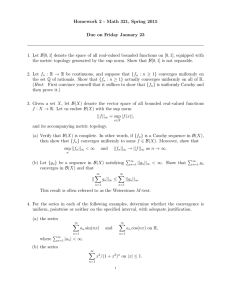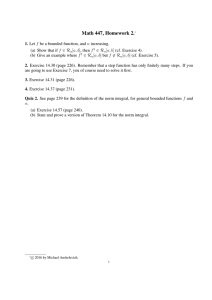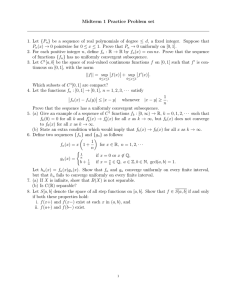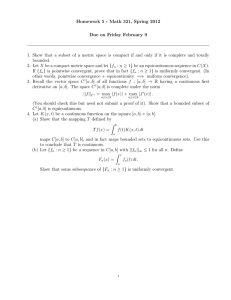Homework 2 - Math 541, Spring 2016
advertisement
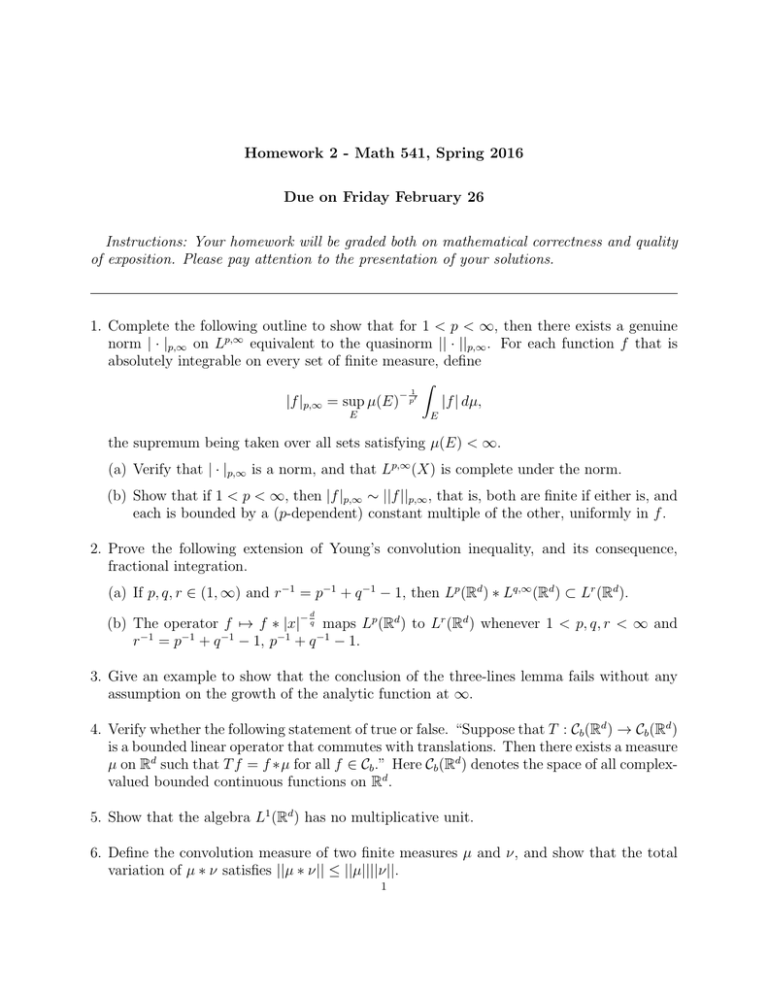
Homework 2 - Math 541, Spring 2016
Due on Friday February 26
Instructions: Your homework will be graded both on mathematical correctness and quality
of exposition. Please pay attention to the presentation of your solutions.
1. Complete the following outline to show that for 1 < p < ∞, then there exists a genuine
norm | · |p,∞ on Lp,∞ equivalent to the quasinorm || · ||p,∞ . For each function f that is
absolutely integrable on every set of finite measure, define
Z
− p10
|f |p,∞ = sup µ(E)
|f | dµ,
E
E
the supremum being taken over all sets satisfying µ(E) < ∞.
(a) Verify that | · |p,∞ is a norm, and that Lp,∞ (X) is complete under the norm.
(b) Show that if 1 < p < ∞, then |f |p,∞ ∼ ||f ||p,∞ , that is, both are finite if either is, and
each is bounded by a (p-dependent) constant multiple of the other, uniformly in f .
2. Prove the following extension of Young’s convolution inequality, and its consequence,
fractional integration.
(a) If p, q, r ∈ (1, ∞) and r−1 = p−1 + q −1 − 1, then Lp (Rd ) ∗ Lq,∞ (Rd ) ⊂ Lr (Rd ).
d
(b) The operator f 7→ f ∗ |x|− q maps Lp (Rd ) to Lr (Rd ) whenever 1 < p, q, r < ∞ and
r−1 = p−1 + q −1 − 1, p−1 + q −1 − 1.
3. Give an example to show that the conclusion of the three-lines lemma fails without any
assumption on the growth of the analytic function at ∞.
4. Verify whether the following statement of true or false. “Suppose that T : Cb (Rd ) → Cb (Rd )
is a bounded linear operator that commutes with translations. Then there exists a measure
µ on Rd such that T f = f ∗µ for all f ∈ Cb .” Here Cb (Rd ) denotes the space of all complexvalued bounded continuous functions on Rd .
5. Show that the algebra L1 (Rd ) has no multiplicative unit.
6. Define the convolution measure of two finite measures µ and ν, and show that the total
variation of µ ∗ ν satisfies ||µ ∗ ν|| ≤ ||µ||||ν||.
1
2
7. We had an informal discussion in class about the metaprinciple that convolutions tend to
smooth functions out. The following results, which you should prove, are a few instances
of this general philosophy.
0
(a) Fix any p ∈ [1, ∞]. Given any f ∈ Lp and g ∈ Lp , their convolution f ∗ g is a
continuous (!) function, vanishing at infinity (!) if p ∈ (1, ∞). Here p and p0 denote
dual exponents, i.e., p1 + p10 = 1.
(b) Let 1 ≤ p ≤ ∞, γ > d and k ≥ 0. Suppose that ϕ ∈ Cbk (Rd ) with
α
∂ ϕ(x) ≤ C(1 + |x|)−γ for all x and all |α| ≤ k.
Then for any f ∈ Lp , one has that f ∗ ϕ ∈ Cbk , with ∂ α (f ∗ ϕ) = f ∗ ∂ α ϕ for all α
with |α| ≤ k. Moreover, ||f ∗ ϕ||Cbk ≤ C||f ||p for some constant C independent of f .
d
Here Cbk (Rd ) denotes the space of k-times
P continuouslyαdifferentiable functions on R ,
equipped with the norm ||g||Cbk (Rd ) = |α|≤k supx∈Rd |∂ g(x)|.
(c) If the function f in part (b) is chosen to be in Cb` instead, show that f ∗ ϕ ∈ Cbk+` .
8. Let {ϕj } ⊆ L1 (Rd ) be an approximate identity family, i.e., obeys the following three
properties:
Z
Z
(i)
ϕj −→ 1,
(ii) sup ||ϕj ||1 < ∞,
(iii)
|ϕj (x)| dx −→ 0 ∀δ > 0.
j→∞
j
|x|>δ
j→∞
We showed in class that f ∗ ϕj → f uniformly if f ∈ Cc (Rd ) and in Lp -norm if f ∈ Lp . 1
To what extent do these convergence results characterize the three properties (i)-(iii) of
an approximate identity family? We try to explore this converse direction in the following
sequence of problems.
1
d
(a) Suppose that {ψj : j ≥ 1} is a subset
R of L (R ) satisfying ||f ∗ ψj − f ||1 → 0 as
1
j → ∞ for every f ∈ L . Prove that ψj → 1 as j → ∞ and that ||ψj ||1 is bounded
uniformly in j.
(b) Show that there exist sequences {ψj } ⊆ L1 (Rd ) such that f ∗ ψj → f uniformly for
all f ∈ Cc (Rd ), yet {ψj } does not satisfy part (iii) of the definition of an approximate
identity sequence.
(c) Show that there also exist such sequences satisfying ||f ∗ ψj − f ||1 → 0 for all f ∈ L1 .
1We
R
assumed that ϕj = 1 for all j, but convince yourself that the proofs go through with minimal
modifications if this requirement is replaced by the milder (i) above.
